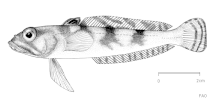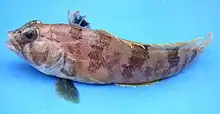Lepidonotothen nudifrons
Lepidonotothen nudifrons, the yellowfin rockcod, also known as the yellow notie or the gaudy notothen, is a demersal species of notothen found in the waters of South Georgia and the islands of the Scotia Arc (e.g. the South Sandwich and the South Orkney Islands) in the Southern Ocean at depths of 5 to 350 m (16 to 1,148 ft). This species can grow up to 19.5 cm (7.7 in) TL.[1][2]
| Yellowfin rockcod | |
|---|---|
 | |
| Illustration | |
 | |
| Specimen from the South Shetland Islands | |
| Scientific classification | |
| Kingdom: | |
| Phylum: | |
| Class: | |
| Order: | |
| Family: | |
| Genus: | |
| Species: | L. nudifrons |
| Binomial name | |
| Lepidonotothen nudifrons Lönnberg 1905 | |
Males of this species are one of the most brightly-colored fishes of the Antarctic, with a warm orange-brown body color and brown bars, orange first and second dorsal fins, silvery white belly and a large black spot and short yellow bars on the dorsal fins. The ventral parts are pale. The pelvic fins are pale yellow with faint brown bars present (these are also present on the caudal fin together with pale yellow bars). There are irregular dark blotches and spots on the body. Most of this coloration is lost after preservation in alcohol, with 5 dark cross-bars formed. There are no scales present on the head. Adult females and immature specimens are nearly uniformly pale yellow or pale yellowish-brown.[2][1]
Adults of this species mainly feed on polychaetes, amphipods and isopods, however, fish eggs and shrimps are also taken. Juveniles and smaller adults mainly feed on copepods.[2]
Spawning takes place from April to October, with sexual maturity reached at 9 cm (4 in) SL. As much as 6,886 eggs of up to 2.5 mm (0.1 in) diameter are laid under the cover of rocks and guarded by the male for about four months. Hatching begins in September and the larvae measure 7 mm (0.3 in) TL.[2]
This species is of no interest to commercial fisheries.[3]
References
- Miller, Robert G (1993). A History and Atlas of the Fishes of the Antarctic Ocean. Nevada, USA: Foresta Institute. p. 792.
- Gon, Ofer; Heemstra, Phillip C. (1990). Fishes of the Southern Ocean. Grahamstown, South Africa: J.L.B. Smith Institute of Ichthyology. pp. 299–300.
- "FAO Catches List". www.fishbase.se. Retrieved 2020-12-22.